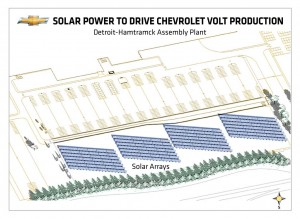General Motors has been telling potential buyers to plug in with the new Chevrolet Volt extended-range electric vehicle. Now the maker wants to do the same thing, plugging into a new solar power array at the Volt plant in Detroit.
The 516-kilowatt grid will be the largest in the region and is expected to provide enough power to keep 150 Chevy Volts fully powered at all times. Were the system used to charge up the plug-in hybrids as they roll off the assembly line, before shipment to customers, the solar array would be able to handle nearly 55,000 of the battery cars annually – significantly more than GM has plans to produce in the near future, so surplus energy will help power the plant itself.
“This array will significantly decrease energy consumption by combining solar power with ongoing efficiency tactics such as lighting and equipment upgrades and automating equipment shut-down,” said Bob Ferguson, vice president of GM Public Policy.
The 264,000 square-foot solar array is being developed in cooperation with local power provider DTE Energy, which is investing $3 million into the project. That underscores the challenges proponents of green energy face making a viable business case. The array is expected to cut GM’s energy bill by $15,000 annually, which means the so-called payback period would stretch out over several centuries.
The panels will cover much of a six-acre tract on the south side of the Detroit-Hamtramck Assembly Plant, known locally as Poletown. By facing due south the array should deliver maximum power.
GM isn’t the only automaker betting on the sun. Audi is also expanding several solar power projects at its plants in Europe. Honda, meanwhile, has a pilot program ongoing in sunny Southern California, using solar energy to electrolyze water and create hydrogen for its FCX fuel cell vehicle.


Does GM have more orders for the Volt than they can fill now that gas prices have increased?